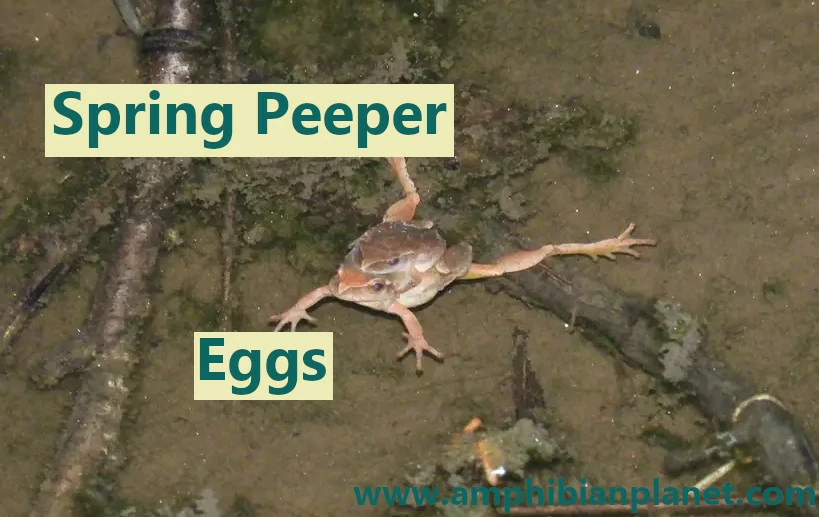Spring peepers (Pseudacris crucifer) are small, slender tree frogs found throughout much of the eastern part of North America. Like most frogs, spring peepers reproduce by laying eggs.
These eggs are laid in shallow, fish-free freshwater bodies and attached to submerged vegetation near the water’s surface.
Unlike most frogs which lay their eggs in masses, Spring peepers lay their eggs in small clusters, usually in rows attached to the same stick.
Learning about Spring peeper eggs is great to add to your knowledge and feed your curiosity. Read on to find out everything you need to know about Spring peeper eggs including some really interesting facts, as well as how to easily identify them.
When Do Spring Peepers Lay Their Eggs?
Spring peepers breed in southern areas from breed October to March, depending on the environmental temperature. In Northern areas, they breed from March to June, when the first spring rains come.
Spring peepers are often one of the first frogs to start breeding in the spring, not long after the ice melts on the wetlands.
For many people in the eastern and upper midwestern United States, their peeping is often an indicator that spring has arrived.
Spring peepers will usually start their breeding calls when the ambient temperature is (82.4°F) 28°C.
Where Do Spring Peepers Lay Their Eggs?
Spring peepers prefer to breed in shallow, temporary, or semi-permanent wetlands and ponds – that are only present in the spring and dry up as the year progresses.
Spring peeper breeding habitats include woodland ponds, vernal pools, flooded fields, flooded ditches, open marshes, swamps, wet meadows, cypress heads, and pine barrens.

In general, ideal spring peeper breeding ponds are near woods and are large and permanent enough to support emergent vegetation, but too shallow and temporary to contain fish.
Like many other amphibians, Spring peepers will typically avoid breeding in water with fish, as fish often prey on amphibian eggs and larvae.
How Do Spring Peepers Lay Their Eggs?
Male spring peepers arrive first at the breeding sites and will gather at the edges of pools by the hundreds – hidden near the bases of shrubs or grasses.
Each male establishes a small territory (usually occupying the immediate area around an individual) and begins calling for females.
This call is described as a high-pitched “peep peep peep”, repeated about 15-20 times per minute. The louder and faster he peeps, the better his chances of attracting a receptive female.
Listen to Spring peepers calling:
The males usually compete in trios, and the one who starts each round is usually the deepest-voiced.
Female spring peepers choose their mates based on the speed and volume of the male’s calls. Larger males are also typically preferred.
Once the female finds the male they are most attracted to they let the male know by nudging him.
The male then grasps the female behind her forelimbs in a tight mating embrace called ‘amplexus’.
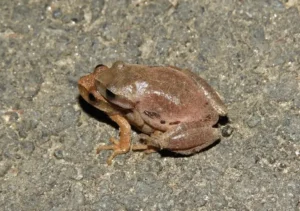
Once in the amplexus embrace, the pair will swim around as the female chooses a site to lay her eggs. The female then lays her eggs in jelly-like strings, and the male releases sperm into the water, to fertilize the eggs as the female lays them.
Unlike many frogs which lay their eggs in masses, Spring peepers lay their eggs singly or in clumps of two or three.
The eggs are attached to submerged vegetation or debris, just below the surface of the water.
How Many Eggs Do Spring Peepers Lay?
A single female Spring peeper can lay 900 to 1,000 eggs each breeding season.
Each frog will only lay eggs once yearly, and will not breed multiple times in the same season.
Why Do Spring Peepers Lay So Many Eggs?
Spring peepers, like other frogs, lay large numbers of eggs as a natural way to counter the extremely high mortality rates they experience in their early life stages.
Spring peepers leave their eggs shortly after laying them. This means the eggs (and tadpoles) are vulnerable to predators, and environmental conditions – leading to very low survival rates.
Of the tadpoles that hatch, there will be intense competition for food and limited resources, meaning again the number of tadpoles will naturally thin out.
When the froglets leave the water, only a few will live to adulthood and reproduce – which can be as low as 1%. The rest will get eaten by predators such as birds, snakes, larger frogs, and small mammals such as foxes.
What Do Spring Peeper Eggs Look Like?
Spring peeper eggs are very small and are deposited singly on leaf litter and other underwater substrate.
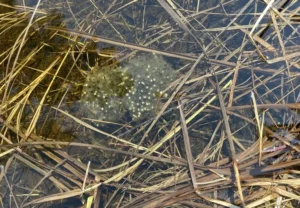
They are not laid in large clusters like egg masses of other common frog species.

Each egg has a yellowish-cream color and is surrounded by a protective gelatinous mass.

Due to their small size, Spring peeper eggs can be hard to see from a distance, so you need to use caution when looking for them – to avoid trampling them.

How Long Do Spring Peeper Eggs Take To Hatch?
Spring peeper eggs take about 6 to 12 days to hatch, depending on the environmental conditions.
The eggs will typically develop and hatch faster in warmer temperatures and slower in colder temperatures.
Spring peeper eggs laid in cooler weather will usually take longer to hatch than those laid in warmer weather.
What Do Spring Peeper Tadpoles Look Like?
Young spring peeper tadpoles are tan/brown with darker mottling and the tail fin is clear.
As the tadpoles age, they gain golden or brassy flecking on the body and large dark blotches along the edges of the tail fins.
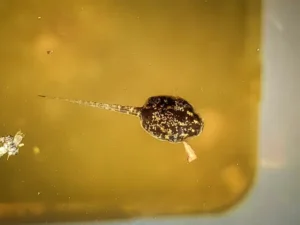
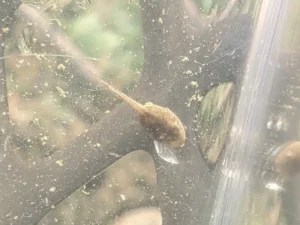

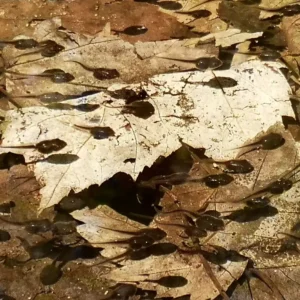
The tadpoles typically grow to 3 to 4 cm in total length before metamorphosis.
Spring peeper tadpoles will complete their metamorphosis and transform into frogs about two to three months after they hatch.
Do Spring Peepers Care For Their Tadpoles?
Spring peepers do not attend to their tadpoles or care for them in any way.
Male Spring peepers will not provide any parental care or investment after fertilization.
Female Spring peepers supply their eggs with nourishing yolk, but once they lay their eggs, they leave the pond, only returning the next breeding season.
What Animals Prey on Spring Peeper Eggs & Tadpoles?
Spring peeper eggs are preyed on by many animals including newts, turtles, leeches, dragonfly larvae, diving beetles, and other large water bugs.
Once the tadpoles hatch, they are preyed on by
- Fish (if present in the pond)
- Dragonfly naiads
- Giant water bugs
- Larger amphibian larvae, such as salamander larvae
- Newts and salamanders
- Some adult frogs, such as American Bullfrogs
- Turtles
- Water snakes
- Wading birds, such as herons
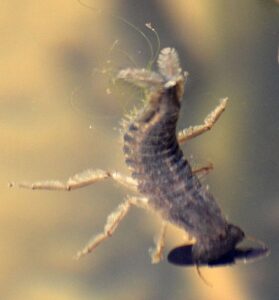
What to Do if You Find Spring Peeper Eggs
If you live near a wooded area, especially near a pond, or another freshwater body there’s a chance of encountering Spring peeper eggs in the spring. If this happens, be sure to avoid disturbing the eggs.
Disturbing or removing the eggs from the water could damage them, or even kill the tiny embryos developing inside the eggs.
If you find frog eggs out of the water, it is best to leave them alone, especially if they are very near the water.
However, if you find frog eggs that were disturbed (by a human or animal) and taken out of the water, you could try to put them back in the water.
If the egg mass is still attached to a stick, very gently put the stick back in the water (just a few inches below the surface).
Still, the eggs are not guaranteed to hatch because the disturbance may have damaged them or killed the embryos developing inside.
Of course, there’s no harm in observing Spring peeper eggs from a distance.
Featured image credit: Gray Catanzaro (CC BY-NC 4.0 DEED)
Sources:
Lykens, D. V., & Forester, D. C. (1987). Age Structure in the Spring Peeper: Do Males Advertise Longevity? Herpetologica, 43(2), 216–223. http://www.jstor.org/stable/3892054
Gary M. Lovett “When Do Peepers Peep? Climate and the Date of First Calling in the Spring Peeper (Pseudacris crucifer) in Southeastern New York State,” Northeastern Naturalist 20(2), 333-340, (1 June 2013). https://doi.org/10.1656/045.020.0209
Stewart KA, Austin JD, Zamudio KR, Lougheed SC. Contact zone dynamics during early stages of speciation in a chorus frog (Pseudacris crucifer). Heredity (Edinb). 2016 Feb;116(2):239-47. doi: 10.1038/hdy.2015.96. Epub 2015 Dec 2. PMID: 26626576; PMCID: PMC4806893.
Sullivan, B. K., & Hinshaw, S. H. (1990). Variation in Advertisement Calls and Male Calling Behavior in the Spring Peeper (Pseudacris crucifer). Copeia, 1990(4), 1146–1150. https://doi.org/10.2307/1446500
Donald R. Baud, Melvin L. Beck “Interactive Effects of UV-B and Copper on Spring Peeper Tadpoles (Pseudacris crucifer),” Southeastern Naturalist, 4(1), 15-22, (1 March 2005). https://doi.org/10.1656/1528-7092(2005)004[0015:IEOUAC]2.0.CO;2
Skelly, D. K. (1996). Pond Drying, Predators, and the Distribution of Pseudacris Tadpoles. Copeia, 1996(3), 599–605. https://doi.org/10.2307/1447523

